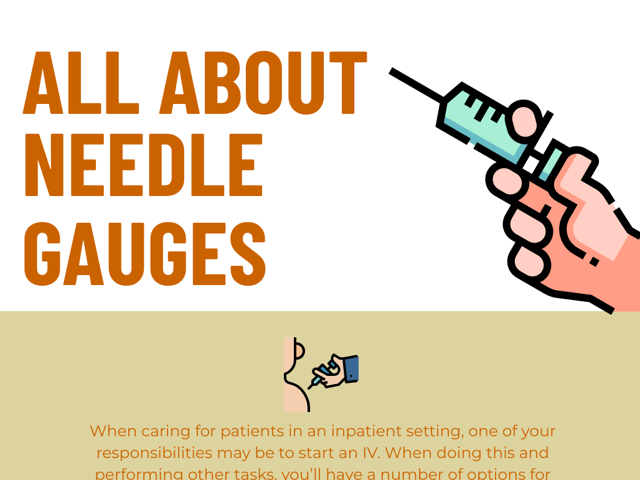
All About Needle Gauges
When caring for patients in an inpatient setting, one of your responsibilities may be to start an IV. When doing this and performing other tasks, you’ll have a number of options for needle gauges, and the appropriate needle gauge will depend on the patient’s needs. It is important to find the right gauge the first time to avoid having to stick that patient again.
Needle Size and Choice
Needle gauges are sized numerically, with the smaller numbers correlating to larger needles and larger numbers correlating to smaller needles. In general, the smallest appropriately sized needle is used. The most common sizes are 18, 20, and 22 gauge. As always, review your facility’s policy to ensure you are familiar with what fluids, products, and medications can be administered through certain gauges.
Other Considerations
The gauge size also varies with the purpose of the stick. For example, if the patient needs to have blood drawn or requires infusion of blood products, some of the smaller gauges may be contraindicated because the small bore can damage the cells.
Basic Needle Gauges and Uses
Remember that the larger the needle gauge number, the smaller the size of the needle. These are the more commonly used needle gauges and their general purposes:
16 Gauge: Outside of the ICU or operating room, these large bore needles are rarely used. In critical care areas, the large size of the IV needle/catheter allows for rapid infusion of fluids or blood products.
18 Gauge: This size can be used for rapid blood and fluid administration, although not quite as rapid as with a 16 gauge.
20 Gauge: This size is better for patients with smaller veins. It may be possible to administer blood through this size IV if an 18 gauge IV is not possible, but some facility policies may not allow it.
22 Gauge: If the patient is not critically ill or will only require an IV for a short period of time, this size IV needle may be appropriate. It is usually too small for blood products to be administered.
24 Gauge: This small size IV needle/catheter is less common in the adult population. It is more appropriate for use with pediatric patients.

Keep Reading

Health Education Systems Incorporated Exam Blog
HESI Anatomy and Physiology Review: A Comprehensive Guide
As you prepare for the Health Education Systems, Inc (HESI) Admission A…

Health Education Systems Incorporated Exam Blog
How to Pass the HESI Exam: A Comprehensive Guide to Acing Your Nursing Entrance Exam
If you’re considering becoming a nurse, the HESI exam can be a crucial …

Health Education Systems Incorporated Exam Blog
The Complete Guide to HESI Exam Scores
Are you ready to become a nurse? Many nursing schools require entrance …